DREAM
MATCH TENNIS PRO GUIDE V 1.21
by
Yann
LEGAL
INFORMATION
Dream
Match Tennis Pro is a trademark of Bimboosoft Co. Ltd. All information contained
within this document is the author's original work. This document cannot be
altered or edited under any circumstances other than by the author or
Bimboosoft. No portion of this document can appear in any form within any other
document or web site without the author's or Bimboosoft's permission.
1)
INTRODUCTION
Through
Dream Match Tennis, the goal of Bimboosoft was to create a game that lets you
play real tennis on your computer. Therefore Dream Match Tennis is a full tennis
simulation and the depth of the gameplay requires some training, as it is the
case in reality.
Even
though it appears more difficult than arcadish tennis games, it is also a much
more rewarding experience in the long term. So practice your shots and control
the ball to become an accomplished tennis player !
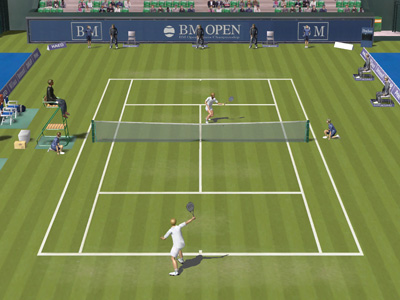
2)
CONTROLS AND MODES
D-Pad (or
keyboard arrows by default) : to move the player and to control the
direction of the shots
Shots
Keys (D, S, A, W, E and Q by default) : Normal (top spin), Hard (flat), Slice, Lob,
Drop and Super Hard shots.
Action
key 1 (1 by default) : to make the ball rebound before your serve or let
the player express his emotions after a point (the reaction depends on the
situation).
Action
Key 2 (2 by default) : to watch a replay
F1
: to display help
Esc
: to display the Menu
F7-F8
: to change the camera angle
PageUp
PageDown F5-F6 : To zoom in or out the camera
Enter
: To chat
There
are 6 modes in DMTP
-
Exhibition : to play an exhibition match in singles or doubles. A large choice
of options can be set : Courts, number of sets, size of the ball, type of the
camera, clothes colors, difficulty and of course the players.
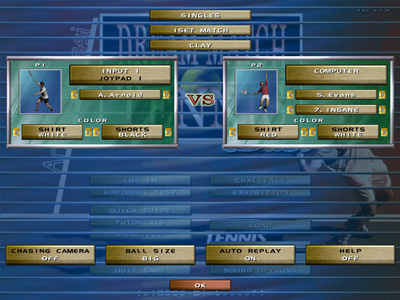
-
Online game : to compete against players from all around the world
-
Tutorial : to learn the basics of DMTP’s gameplay
-
Practice : to practice each separate shot, serve, groundstrokes, volley and
overhead. Speed, type and direction of the shots can be chosen (via Escape key)
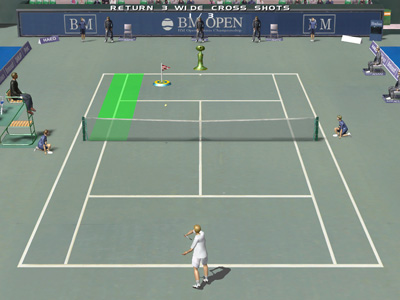
-
Challenge : try to beat 4 players in a row on 3 different courts, the difficulty
improving with each match.
-
World Tour : A complete career mode where you try to become the World #1 ! It
features 12 Tournaments and a large ranking system with 128 players. Each
tournament has a full draw where you can see the other players’ results. Once a
match has started, you can withdraw by selecting the option (Escape key while in
a match).
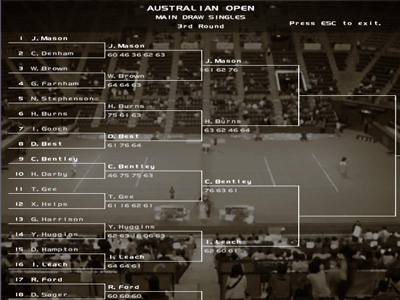
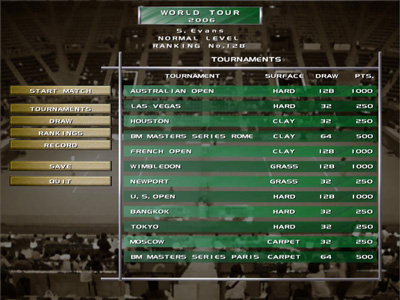
3)
FAQ
-Q:
How many players are there in this game? Are there some that can be unlocked?
A:
There are eleven men and one woman, all available from the beginning.
-Q:
Can we choose the number of sets and/or games? Can we choose who will serve
AND
can we also choose the server at random?
A: There can be 1, 3 or 5 sets, the
default number in the World Tour Mode is just a suggestion.
-Q:
Can we play both with the same character? Can we play women against men in
singles?
Can we play up to 4 players in doubles?
A: Just one answer "YES", this game
features a lot of options.
4)
PLAYING STRATEGIES BASICS
Tennis
is based on a simple goal: "Placing the ball inside the limits of the court once
more than the opponent".
So
two strategies can be used: either attacking in order to prevent the opponent
from placing (or touching) the ball inside once more (Strategy 1) -or- waiting
for him to make a mistake (fault).
To
perform these strategies, tennis is based on the variety of:
-Speed
of the shots
-Effects
(slice, lift, flat)
-Direction
and angle of the shots
-Length
of the shots
Mental
and physical aspects are also a great part of tennis, but since this guide is
about a game, mental elements (like concentration) and physical elements (like
your fingers' endurance) are supposed to be managed by yourself...
Thanks
to Bimboosoft, DMTP doesn't suffer from the worst and most dangerous problem of
the new tennis games: the LACK OF ANGLE SHOTS.
Its
gameplay is based on timing and on top of that DMTP features realistic faults
and therefore corrects one of the biggest flaws of many arcadish tennis games.
Thus
in real tennis, you can place the ball anywhere from anywhere without needing
preparation. Indeed, preparation is needed for precision and so for power, but
not for gaining angle.
For
instance, being at the left extremity of the court (A), you can play a cross
angle shot just behind the net on the opposite extremity of the court (b)or a
long cross shot (c) as well as down the line (e):
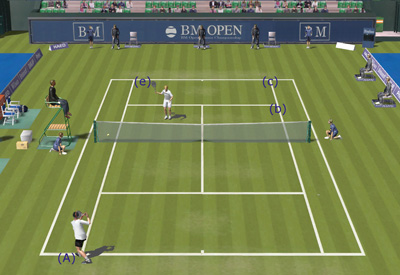
The
problem is that nowadays, many tennis games lack angles because they are based
on the FALSE theory that angles shots need preparation and are more difficult to
play than down the line shots.
Even
worse, some doesn't allow the player to place the ball wider than a semi-court.
THIS
IS VERY DANGEROUS FOR THE INTEREST AND THE VERY ESSENCE OF TENNIS GAMES !!!!!!
Remember
Pong, what would have been the interest without angle/cross shots?
Thus,
removing basics elements like faults and angle will transform tennis games into
a ping-pong like sport where you can only play down the line, in front of you,
which has nothing to do with tennis !!!! (note that I like Ping Pong, it is only
used to express the idea of speed through the image).
After
this call to rebellion, let's get back to basic strategies.
#
First, the placement and footwork of the player:
In
tennis, there are only two standard positions, the baseline and the volley.
So
the middle of the court (plan 1, position A) and the far back of the court (plan
2, position B) are only positions of transition where you mustn't stay.
Plan
1
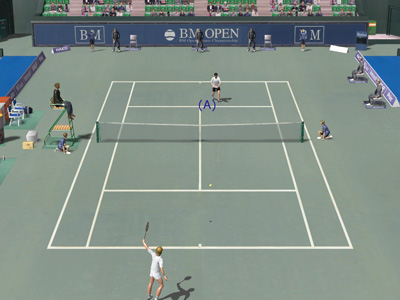
Indeed,
position (A) is both too far from the net which lets a lot of room for your
opponent's passing shot and also too close to the net because you have not
enough time to react and choose which shot you will play.
Plan
2
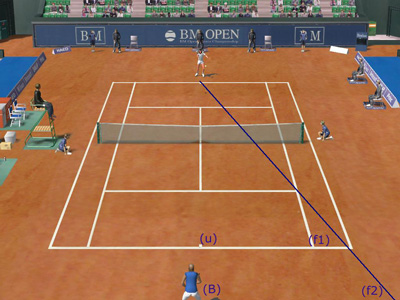
Position
(B) lets you a lot of time to react and prepare your shots, but dropshots will
become deadly (d) and angle shots will go further from you (f).
If
(B) was at the baseline (u), the angle shot will come closer. indeed the
distance between (u) and (f1) is inferior to the distance between (B) and
(f2).
Basically,
there are 2 main ways of attacking:
-the
one used by strong groundstroke players like Agassi or Nadal : they try to win
by staying at the baseline.
-the
other one is the serve and/or volley like Edberg or Henman: they try to play
great shots (serves or grounstrokes) in order to rush to the net, taking the
ball the earliest possible. They tend to be very close to the net (but not too
much because of the lobs).
These
both strategies are great and your way of playing depends on your tastes.
Nevertheless
the volley strategy is riskier than the baseline one, and requires better
reflexes and some more practice, but is also more spectacular.
#
Second, the shots and effects:
The
top spin (or lift) : the ball turns forwards, its rebound is rather high, and it
accelerates as it rebounds. A safe but rather slow shot.
The
slice : the ball turns backwards, its rebound is low and slows the ball. Very
useful to defend or to rush to the net.
The
flat shot : as its name says, it is free of effect so its rebounds is fast and
somehow low. It is riskier than top spin shot but also the more efficient to hit
winners. When the player has enough preparation time, it can be hit even
stronger.
The
drop shot : a very short shot that falls just behind the net with a very low
rebound. This is a poker like shot, very efficient but use it wisely!
The
lob shot is usually used when the opponent is at the net and very close from it.
It is very high and somehow long in order to pass over the opponent, (remember
that if it is too short or not surprising enough, your opponent may crush you
with an overhead, so use it also wisely.)
Both
the dropshot and the lob need a lot of practice to be mastered, otherwise they
will put you in a difficult situation.
#
Third, the angles and length of the ball:
The
whole gameplay of Dream Match Tennis Pro is based on the “swing” system. The
earlier you hit the ball, the wider the cross court shot will be. On the
opposite, down the line shots can be made by hitting a little later than cross
court shots. It takes time to master, but
By
using diagonals, you can vary the length and the angle of your shots. Even when
serving, after throwing the ball in the air, keep the D-pad in any
diagonal/direction, so you can aim at the place you want, but timing and
practice are obviously needed.
I
repeat, the longer you press the d-pad, the more your ball will go to that
direction.
For
the shots, a long shot (D-pad forwards) will go higher and slightly faster than
a short shot (D-pad backwards), but a short shot will have more angle.
So
vary them in order to make your opponent run a lot, combined with the
counterfoot shot. For this, look into the following advanced strategy of
playing.
#Fourth,
playing in doubles:
Basically,
at least one player should stay at the net. Moreover, when one player has to
play a ball on his partner's side, immediately switch to the other side (where
he left an empty room). Finally, since it is more difficult to play winning
shots, focus on strategy, variety, counter shots and patience.
And
don't forget to aim at the middle of the court or between the 2 opponents!
5)
PLAYING STRATEGY ADVANCED
This
section is a list of advice and hints.
-Once
trained enough to get a perfect timing for all shots (that changes everything!),
one of the most important technique to master is the running shot, as its name
says it’s a shot you play while running. Note that you can place it wherever
you want (cross court shots are very effective), you just have to press the
D-Pad towards the desired direction at the very moment of your shot.
-
There are different levels of "nice" shots that you can hear when playing by the
sound of the impact of the ball. The quality of your shots depends both on the
timing and the placement of the player. Of course hitting always "nice" shots is
therefore your goal.
Remember,
in DMTP, timing is everything!!!
-Look
at what your opponent is doing, so that you can play counterfoot shots by
playing a shot to the place opposite to where he runs.A very efficient Strategy
at high difficulty levels.
-When
you see that your opponent will have difficulties to return your shot, do not
hesitate to rush to the net to finish the point.
-By
taking the ball earlier and earlier, your shots will go further and further from
your opponent until he cannot touch them anymore. Plus, the rhythm you give to
the rallies will probably exhaust human opponents.
-The
drop and lob strategy : If you perform drop shots and lobs easily, this strategy
becomes ultra annoying for your opponent. Indeed as the name says, it consists
in playing a drop shot, immediately followed by a lob, then a drop and so on.
Therefore your opponent will run a lot and go crazy.
But
use this strategy wisely...
-Most
of the time, it is better to play "nice" shots, but do not underestimate defense
shots. Indeed, when you are in trouble and when you think that your opponent's
next shot will finish the point, you can still try a ultimate winning point (if
you are sure of it), but it is often wiser to play a slow slice shot to gain
time in order to get back into the point.
-By
going far into the angle shots, you will notice that the angles tend to become
wider and wider as you take the ball earlier. This is a curving effect that
gives even more efficiency to the angle shots, and with some practice this is a
ultimate technique.
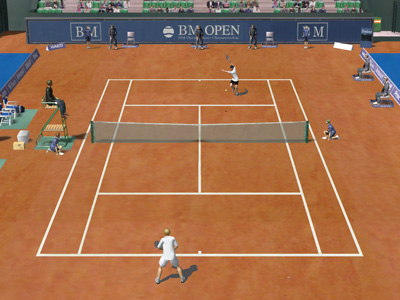
Doubles
Tips
:
-First
of all, be careful when hitting deep volleys as you can easily volley the ball
out. It's probably best to just use the left and right stick movements (and of
course centre) for volleys, unless you're really good.
-When
you're serving and your partner's at the net, serve out wide, move to the net
and volley back to the receiver of the serve (unless there's an obvious centre
opening). Your opponent will usually hit to your partner and he will eventually
make a volley winner. Volley any ball hit towards you back to the receiver (of
the serve), unless there's a really obvious opening.
-When
your receiving and your partner's at the net, hit the return back to the server,
run to the net and volley any ball hit towards you back towards the server
(unless there's an obvious centre opening). Again, your partner will eventually
make a volley winner when the ball is hit towards him. Volley any ball coming
your way back to the server, unless there's a really obvious opening.
-When
your partner's receiving and you are at the net, move into the doubles lines and
wait for any ball hit towards you. When this happens, you can normally hit a
volley winner into the centre of the court by just pressing the volley button
without adding a direction).
-If
you are involved in any net exchanges then press the volley button as soon
as
you see or HEAR your opponent make a volley. But, as in reality, you have to be
really quick and have good anticipation.
-If
you decide to stay back, then remember to hit deep topsin shots to the centre
(just push upon the D-Pad) as well as those to the left or right.
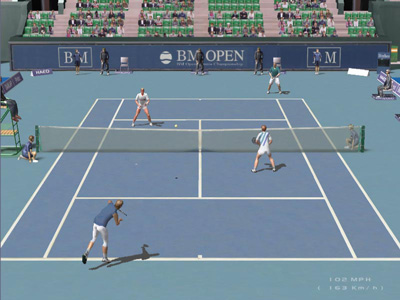
6)
COURTS AND CHARACTERS
-There
are 4 courts in this game :
Hard
(fast and normal rebound)
Grass
(very fast and very low rebound)
Clay
(slow and rather low rebound)
Carpet
(rather fast and low rebound)
Realistically,
the surface of the courts has a lot of incidence on the way of playing.
It
is obvious, but the game will be slower on clay and losing ones serve will be
less dangerous on clay than on grass.
So
you have to adapt your way of playing to the surface.
-There
are 12 players in this game :

Gibson
: The only woman. Great forehand, solid backhand (often sliced), good serve, in
short a fantastic baseliner.

Evans
: The best volley player, he often rushes to the net following his very
efficient serve (with a lot of top spin). Despite his average forehand, he is
still dangerous from the baseline thanks his magnificent one handed backhand.

Arnold
: The best double handed backhand and one the greatest forehand in tennis
history, he can hit winners anytime from the baseline. Rather poor volley and average serve
though.

Scott
: An all-around player with a powerful serve, a great volley and a lightning
forehand. Flawless, or so it seems...

Mason
: Lacks power from the baseline, but a fantastic net player with an amazing
touch. His speed and variety of effects can always turn a match around.

Cooper
: Gifted with an amazing footwork, this baseline player almost never makes
mistakes and can hit fantastic passing shots.

Leach
: Though very bad at the net and a little slow to start running, he has a one of
the best forehands and serve in the game. Moreover, he varies his backhand's
effects very efficiently.

Baron
: Despite being a little heavy, this all-around player has both great
groundstrokes and volley associated with a booming serve.

Nelson
: Not only is he the fastest player, but he also has a monstrous forehand and a
great backhand. Moreover, his volley and serve are very solid as well, although
he tends to keep playing from the baseline.

Ford
: A marvelous all-around player, each of his shots being among the bests. On top
of that, his blazing serve and the spin he can add to his groundstrokes make him
as good whatever the type of the court.

Banks
: Considered as a wall from the baseline, this consistent player is as good on
fast courts as on clay.
![]()
Cain
: In spite of his slow serve, this huge fighter can hit flat groundstrokes
winners from anywhere on the court, being also rather efficient at the net.
Copyright
ゥ 2005-2006 Bimboosoft Co., Ltd. All Rights Reserved.